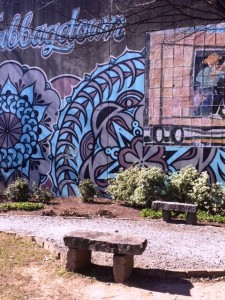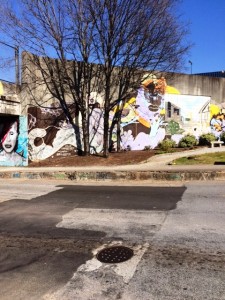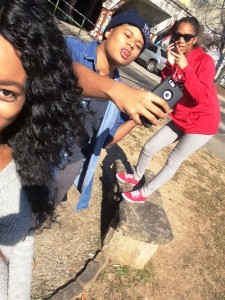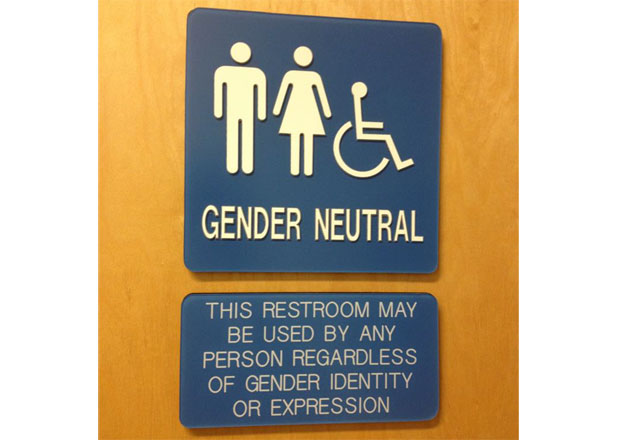KROG STREET TUNNEL
For my first built environment description I chose to observe and document my trip to the historical Krog Street Tunnel. This location happens to be one of my favorite scenic places to visit in Atlanta. Krog Street Tunnel is an open creative space for artists to utilize. It links Inman park and Cabbagetown neighborhoods. It’s used as a canvas for those that are artistically inclined, a place for fitness, transportation, and a place of solitude for some. Below you will find a documented account of my visit with descriptions included.
ARRIVAL (mid- afternoon 2/12)
Two of my closest friends and I arrived at Krog Street Tunnel mid-afternoon in a Lyft. The driver was confused why 3 students wanted to be dropped off in a secluded graffiti tunnel, but was too distracted by the immense amounts of artwork that draped the walls of the tunnels to question us further. Luckily the weather was perfect (not too cold, a slight breeze, and the sun was out) so the 3 of us eagerly jumped out of the car.
Th e first piece of artwork that I laid eyes on said “Sexism isn’t sexy”. This quote spoke to my inner feminism and set the tone for the entire visit. This quote was located on the outside of the tunnel when you first enter. It was very hard to miss, definitely an attention grabber. Feelings such as: bold, energetic, admiration, brave, and liberated describe how I felt upon seeing the artwork above.The quote set the tone of the tunnel and basically establishes the “carefree” and “uncensored” nature of this space. Another piece of artwork that grabbed my attention was the “Dope” graffiti. This piece of artwork also spoke volumes and I believed described the tunnel perfectly. It was pretty dope.
e first piece of artwork that I laid eyes on said “Sexism isn’t sexy”. This quote spoke to my inner feminism and set the tone for the entire visit. This quote was located on the outside of the tunnel when you first enter. It was very hard to miss, definitely an attention grabber. Feelings such as: bold, energetic, admiration, brave, and liberated describe how I felt upon seeing the artwork above.The quote set the tone of the tunnel and basically establishes the “carefree” and “uncensored” nature of this space. Another piece of artwork that grabbed my attention was the “Dope” graffiti. This piece of artwork also spoke volumes and I believed described the tunnel perfectly. It was pretty dope.
Click here for Video: Krog Street Entrance
TRAFFIC NEAR THE TUNNEL
One thing that was hard to ignore while observing all of the artwork in the tunnel was how loud the tunnel made the cars, trucks, people, etc… passing by sound. As I sat in the tunnel and observed the joggers sprinting past, people engrossed in conversations, and dog lovers walking their pets; I couldn’t help but notice that the tunnel made everything sound bigger and louder than it actually was. The hollow space carved out in cement made for perfect acoustics. Even when I began to talk aloud I felt a sense of mysticism. The
I recorded a video for sound purpose below:
Click here : Traffic near Entrance
WALKING THROUGH THE TUNNEL
The inside of Krog Street Tunnel was full of colors, graffiti designs, nicknames, portraits of celebrities, and random drawings. The tunnel had so many things on the walls that I found it overwhelming. My mind could n ot take in the immense amounts of artwork. One of my personal favorites was Oscar the Grouch work. I also found the puppy portrait very interesting. The types of pictures found on the walls varied so much. The themes varied from life changing quotes to jokes about love. You can find just about anything within this tunnel. The people who visit this site also vary just as much as the artwork on the walls.
ot take in the immense amounts of artwork. One of my personal favorites was Oscar the Grouch work. I also found the puppy portrait very interesting. The types of pictures found on the walls varied so much. The themes varied from life changing quotes to jokes about love. You can find just about anything within this tunnel. The people who visit this site also vary just as much as the artwork on the walls.

Click here for video: Inside the Tunnel Cancer is beatable
LEAVING THE TUNNEL

While exiting the tunnel I was overjoyed to see a place to sit and rest my feet (picture to the left). I also was confused whether or not it was the exit or entrance, but then concluded that it probably did not matter. Within my last 15 minutes of observing I ran into an artist spray painting on the wall. His name was Rashad Usry and I had the pleasure of asking him a few questions. I began by asking if he came to Krog Street tunnel often to draw, he replied “Krog Street is really the only place down south that has a free wall, compared to like Miami and other places.” He continued to talk about his art and how he was visiting from Maryland. I found it very interesting that artists were allowed to come from all walks of life and leave their mark on the wall. (Video of Rashad Ursy spray painting below)
 Video of Rasha Ursy: Grafitti Artist
Video of Rasha Ursy: Grafitti Artist








